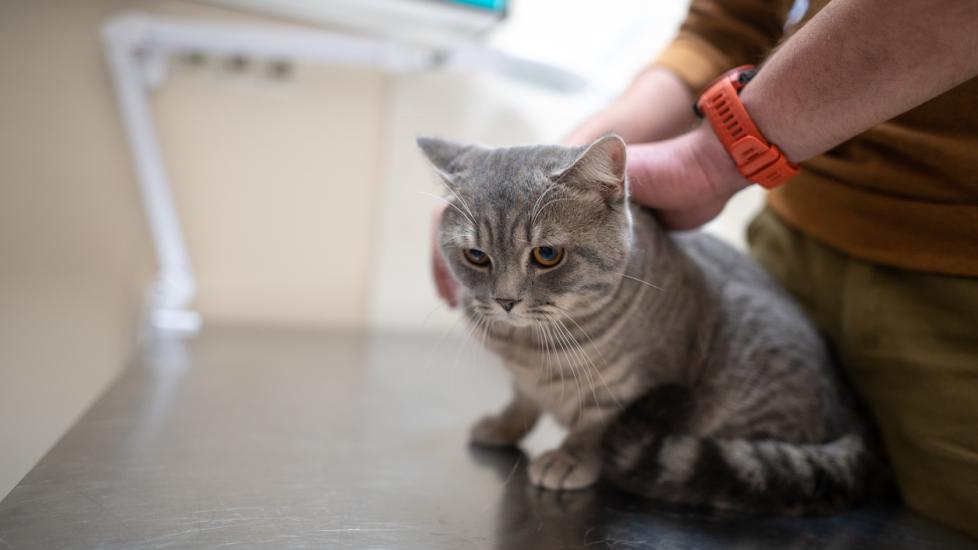Hypoglycemia (Low Blood Sugar) in Cats
What Is Hypoglycemia (Low Blood Sugar) in Cats?
Blood sugar, or glucose, is the main source of energy for both the body and the brain. Low levels of blood glucose, called hypoglycemia, will deprive the body and brain of energy, resulting in unconsciousness. If left untreated, it can lead to death. The opposite condition, high blood glucose levels, is often a sign of diabetes mellitus.
Hypoglycemia is the most common side effect of insulin administration for the treatment of diabetes. The effects of insulin are long-lasting (working for hours), so complications from an overdose will worsen with time, and a pet can progress from stable to critical condition very quickly. As noted, if left untreated, hypoglycemia can be fatal to your cat.
Symptoms of Hypoglycemia in Cats
-
Weakness
-
Lethargy/depression
-
Vomiting
-
Blindness
-
Lack of coordination/stumbling
-
Anxiety
-
Seizures
-
Coma
-
Death
Causes of Hypoglycemia in Cats
Cats under treatment for diabetes are at a higher risk for developing hypoglycemia. Mistakes that can be made when administering insulin include:
-
Giving too much insulin
-
Using a mismatched needle and syringe
-
Missing or delaying meals
-
Change in the diet or amount fed
-
Change in time of insulin administration
Other causes of hypoglycemia in cats that are unrelated to the administration of insulin for diabetic patients include:
-
Infection or illness
-
Decreased appetite or vomiting
-
Change in the body’s need for insulin
-
Concurrent hormonal disease
-
Interaction of insulin with other medications
-
Increase in activity
-
Heatstroke
-
Remission of diabetes
How Veterinarians Diagnose Hypoglycemia in Cats
Hypoglycemia can be easily diagnosed in the hospital. A blood glucose level check will reveal a lower-than-normal blood glucose level. In combination with your cat’s history and clinical signs at the hospital, a diagnosis can be made for hypoglycemia.
To determine the underlying cause of the hypoglycemia, a thorough history and review of the insulin administration is required. If inappropriate administration does not appear to be the cause of the hypoglycemia, the following tests may be performed:
-
Blood Chemistry Profile: to assess the health and function of the liver, kidneys, and pancreas
-
Complete Blood Count: to identify abnormal red and white blood cell counts and patterns, which could identify an underlying disease such as anemia, dehydration, or infection
-
Urinalysis: to evaluate kidney function and check for a urinary tract infection
-
Cortisol Test: to reveal abnormalities in the body’s stress hormone, which could affect its ability to metabolize insulin
-
Thyroid Test: to evaluate the amount of thyroid hormone
-
Imaging: X-rays and ultrasounds are used to check for tumors, abscesses, infection in the abdomen, liver shunts, and liver abnormalities
Treatment of Hypoglycemia in Cats
Initially, treatment is aimed at raising low blood glucose levels. Depending on the severity of the blood glucose level and the clinical signs at the time of the diagnosis, treatment can vary to include:
-
Oral Options at Home: If you notice any symptoms of hypoglycemia (as listed above), take your cat to the hospital immediately. For transport to the hospital, pet parents can apply Karo® corn syrup or honey to the gums only. (Do not force anything to be swallowed or into the mouth.) When you arrive at the hospital, be sure to inform the staff of any home treatments you started.
It is important to note that hyperglycemia and hypoglycemia can produce similar signs in cats (stupor, depression, lethargy), so without confirmation of low blood glucose levels, or a known insulin overdose, do not apply more Karo syrup or honey to the gums in diabetic patients.
-
Oral Options at the Hospital: Similar to options at home, a source of glucose is applied to the gums. In the hospital, cats are monitored for changes in their clinical signs and improving blood glucose levels. If levels are very low or cats are not responding to the gum application, an intravenous administration is typically started.
-
Intravenous (IV): The application of glucose to the gums is not as effective as intravenous dextrose. A continuous-rate infusion is beneficial for cats that do not respond to an initial IV dextrose injection.
-
Supportive Care: In severe cases of hypoglycemia, appropriate nutrition and warming are needed. Seizures are treated with anticonvulsant medication.
Once the patient is stable, further investigation of the cause of the hypoglycemia can be performed.
Recovery and Management of Hypoglycemia in Cats
The clinical signs and symptoms of hypoglycemia should improve within minutes of treatment. In cases of a large insulin overdose, however, repeated treatments are needed over time to counteract the long-lasting action of insulin. In those cases, cats may be kept in the hospital for a continuous infusion of dextrose.
Pet parents of a cat with diabetes should always have a source of glucose and a blood glucose monitor readily available to treat confirmed hypoglycemia following an insulin overdose. After an administration of glucose alleviates the obvious signs of hypoglycemia and a cat can eat on their own, small amounts of food should be offered every 1-2 hours until the effects of the insulin overdose have been counteracted.
Ways to decrease hypoglycemia from an insulin overdose include:
-
Maintain strict feeding times (same times each day)
-
Administer insulin near the time of eating
-
Avoid changes in the diet/food (including treats)
-
Schedule routine bloodwork monitoring as suggested
-
Provide a consistent level of exercise and play each day
Keeping in mind the symptoms of hypoglycemia in cats and ways to decrease hypoglycemia from an insulin overdose, you’ll be best prepared to keep your cat safe.
Featured Image: iStock.com/Yelizaveta Tomashevska
